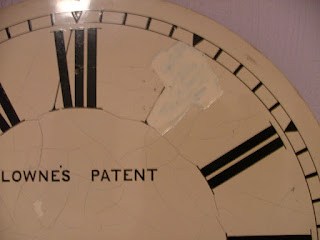An Office Clock from City Hall, Belfast.
I worked
for many years in City Hall. It is a
building with real character (it first opened in 1906), and although working
offices have now largely moved out of City Hall to make way for public display
spaces, there used to be many, many individual rooms within the building.
When I
worked there, each office was allocated a storage area in one of the basement
rooms. These too were fascinating being
full of old ledgers full of beautiful copperplate writing and ancient books of
local bylaws. In one basement that I
used to visit occasionally, there was a huge leather bound volume of these
bylaws (dating from the 1840’s if I remember correctly). My reward for each dusty basement visit was
to open it at a random page to see what I could find. I remember discovering such anachronisms as a
bylaw that banned keeping pigs inside a boarding house. Another specified the amount of straw that
was to be packed around gunpowder barrels when transporting them in carts
through the streets. That was a great
time capsule. I hope it is still safe.
The
basements used to flood during prolonged periods of rain. This, I was told was due to City Hall being
built on the river Lagan’s flood plain. During
construction, the Halls builders had put wooden boards across the wet ground to
make it easier to get building supplies onto site. Each one, of course, then pointed towards
City Hall, and when some were buried during the building work, and then rotted,
they funneled water effectively into the buildings foundations exacerbating the
flooding potential.
In another
basement, lying on a platform that narrowed the further it receded into the
buildings walls, lay a number of the original office clocks for City Hall. There must have been a lot of them at one
stage, but there were only five or six in this basement. It seemed a shame for them to just lie there
and rot, so I asked if I could buy one.
For the princely sum of £5, I became the proud owner of a somewhat
decrepit piece of Belfast history. I
chose the only one that still had a bezel, even though the dial was
damaged. With a little more forethought,
I probably should have cobbled together the best bits of a few of them before
asking if I could buy one. Isn’t hindsight a wonderful thing?
A few
pictures of the clock (in parts) before restoration are below.
You can see
that most of the mechanism was missing, the glass was missing, and as
mentioned, the dial was damaged. Back
then, I had no contacts to get something like this restored, and having asked
in a few local jewelers without finding a restoration solution, I went on
line. Even back then in the mid to late
90’s, there were a lot of on line businesses.
Unfortunately the one I chose turned out to be problematic. I sent off the clock and the required fee,
and then the promised deadline for the fix started to stretch. Over the next year and a bit, I heard a load
of excuses from the restorer, from his problems finding high torque movements
to power the clock’s hands to illnesses, and problems finding sturdy packaging
to send it back. It’s difficult to
believe anything from someone like this after the first thirty or so
excuses! In the end I looked up the
nearest police station to his address and asked them to pay him a visit. The officer I talked to was very helpful, and
strangely enough no more excuses were heard from the restorer, and the clock
arrived in the post within a few days. I
sent my thanks to the officer concerned, but it is worth repeating, the local
police were very helpful, acted quickly and got a good result for me.
The clock’s
movement was originally electrically powered.
A long time after this clock was restored, I went to a local Belfast
watchmaker with my Mum’s Rolex (https://oldandirish.blogspot.com/2018/08/social-history-part-2-rolex-with-story.html).
While waiting for the watchmaker to deal
with another client, I found an article on old electric clocks in one of the
magazines in his workshop. This started
a quick conversation with the watchmaker and provided some interesting
information about the Lownes Patent Mechanism that would originally have been
in the clock. There would have been two
sizes of clock in City Hall, and I know this is true from speaking to other old
Council employees. My clock is one of
the smaller ones. Larger ones would have
resided in more important offices, and had an ingenious mechanism that allowed them
to act as a master for any subsidiary clocks attached to them. Basically, if the time was reset on the
master clock, it would have automatically reset all the smaller clocks it was
attached to. Pretty clever stuff for the
very early twentieth century don’t you think?
Mine now
resides in our hallway, a nice reminder of my time in City Hall.














Comments
Post a Comment
Feel free to leave a comment: I don't use or sell your data, and you will not receive any spam mail as a result.